Bottom sampler is a hydrobiological device for quantitative and qualitative accounting of benthos organisms. Their main purpose is to cut out and capture soil from the bottom of rivers, lakes and reservoirs together with the animals living in it from a certain area of the bottom for the subsequent determination of the species composition of hydrobionts and counting their number. Bottom samplers of different systems and sizes are used, the most popular are Petersen and Ekman-Berge bottom samplers with 1/40 M2 capture area. In shallow reservoirs, rod bottom samplers are used.
Bottom sampler consisting of a bucket with steel flaps (2 to 4) and additional weight. Under the action of the weight the bottom sampler deepens into the ground for 0.2 - 0.4 m, the flaps are closed with a mechanism, holding the sample. The volume of the bottom sampler ranges from several tens of cubic centimeters to 1 square meter. High-volume bottom sampler is called a grabber. A camera is sometimes installed on the bottom sampler frame to take pictures of the bottom before sampling. Disadvantages of the bottom sampler: sludge washing out of it during lifting, poor preservation of fine-grained material when large debris is captured by the flaps.
Bottom sampler
Tags: bottom sampler

